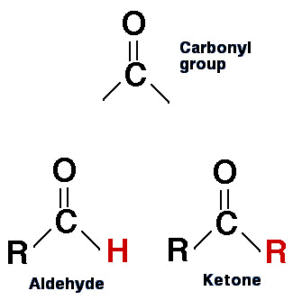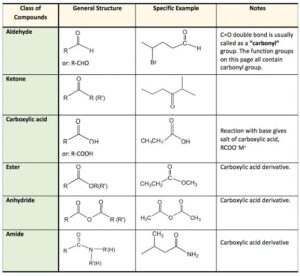Back to: Organic Chemistry 100 Level
Welcome to class!
Hello again, brilliant mind! You’re doing absolutely amazing by consistently showing up for your learning journey. Today, we’re taking one more exciting step into the world of functional groups, focusing on two very important ones—Aldehydes and Ketones. These compounds are all around you, from the food you eat to the medicine in your cabinet. Let’s learn about them together, one simple step at a time.
Functional Groups II: Aldehydes, Ketones
What Are Aldehydes and Ketones?
Both aldehydes and ketones are organic compounds that contain a special group of atoms called the carbonyl group. This group is made up of a carbon atom double-bonded to an oxygen atom (C=O).

What makes aldehydes and ketones different is where this carbonyl group is found in the molecule.
Aldehydes (–CHO functional group)
In aldehydes, the carbonyl group is found at the end of the carbon chain. One side is attached to a hydrogen atom, while the other side is part of the carbon chain.
It’s like the gate of a compound in Lagos—the gate is right at the edge, not in the middle of the house.
General formula: R–CHO (where R is a carbon group)
Examples:
Methanal (formaldehyde) – used in preserving biological specimens
Ethanal (acetaldehyde) – formed during fermentation (e.g., in palm wine)
Naming aldehydes:
Start with the name of the corresponding alkane, remove the “–e” and add –al.
For example:
Methane → methanal
Ethane → ethanal
Uses of aldehydes:
Aldehydes are used in making perfumes, plastics, dyes, and in the food industry. Formaldehyde is used to preserve fish and biological samples in labs and schools across Nigeria.

Ketones (–CO– functional group)
In ketones, the carbonyl group is found within the carbon chain—not at the end. It is connected to two other carbon atoms on both sides.
It’s like having a market stall located in the middle of the street, not at the edge.
General formula: R–CO–R’ (where R and R’ are carbon groups)
Examples:
Propanone (acetone) – used as nail polish remover
Butanone – used as a solvent in industries
Naming ketones:
Start with the name of the alkane, remove the “–e” and add –one.
For example:
Propane → propanone
Butane → butanone
When the carbon chain is longer, you also number the chain to show where the carbonyl group is located.
Uses of ketones:
Ketones are used as solvents in cleaning products, paints, nail polish remover, and even in medicine.
Key Differences Between Aldehydes and Ketones
Position of the carbonyl group: In aldehydes, it’s at the end of the chain; in ketones, it’s in the middle.
Naming: Aldehydes end in –al, while ketones end in –one.

Formula: Aldehydes use R–CHO, while ketones use R–CO–R’.
Real-Life Nigerian Examples
When cassava ferments to make fufu or palm wine brews in the village, aldehydes like ethanal are formed.
The acetone in your aunty’s nail polish remover is a ketone.
In chemistry labs across Nigerian schools, formaldehyde is used to preserve specimens for Biology class.
Summary
- Aldehydes and ketones contain the carbonyl group (C=O).
- Aldehydes have the carbonyl at the end of the carbon chain and are named with –al.
- Ketones have the carbonyl within the chain and are named with –one.
- Both are important in everyday products like perfumes, solvents, nail polish removers, and preservatives.
Evaluation
- What is the functional group present in both aldehydes and ketones?
- How do you tell the difference between an aldehyde and a ketone?
- Give two examples of aldehydes and two of ketones.
- What is the name of the simplest ketone?
- Mention two uses of aldehydes or ketones in everyday Nigerian life.
Amazing work today, champion! You’ve just mastered another vital piece of Organic Chemistry. Understanding aldehydes and ketones brings you closer to decoding the chemistry behind so many things around you. Keep learning, stay curious, and always remember—with Afrilearn, you’re never alone on this journey. See you in the next class!
